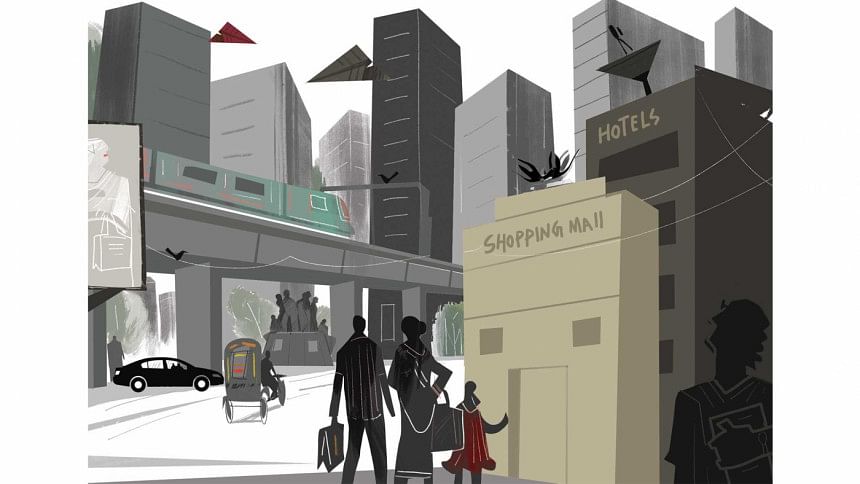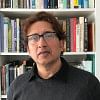A time travel to Dhaka University’s 2034 convocation

It was Titian Matin's first return to his native Bangladesh after he won the Nobel Prize in economics for his study of the reciprocal relationship between urban density and economic geography. As an MIT professor of economics, he was invited to be the keynote speaker at the 2034 convocation of his alma mater: the University of Dhaka. Lillian Roscoe, a Harvard professor of anthropology and Titian's wife, was making her maiden trip to Bangladesh. On the plane to Dhaka, Titian told his wife about his eventful undergraduate years on campus. They planned to spend a few days walking around Dhaka University and feel its academic pulse before the big day.
Lilian was impressed with Dhaka's brand new international airport on the bank of the venerated Padma River, about 40 miles from the city. The elevated expressway from the airport brought them to their Gulshan hotel in less than an hour. The first day in Dhaka was spent with Titian's cousins, reminiscing about their shared childhood stories.
The next day, they went to visit the university campus. On the way to the Teacher-Student Centre or TSC by the elevated metro, Titian was surprised to see how his city had been radically transformed with all kinds of sinuous flyovers, multilevel expressways, metro rail stations, swanky hotels, and shopping arcades. Only tiny fractions of Dhaka's sky could be seen through a high-rise concrete forest.
When they disembarked from TSC metro stop in front of Bangla Academy, Titian pointed to the area where Dhaka's iconic Ekushey Book Fair used to take place on a sprawling compound, now crowded with the massive piers of the metro rail, station, high-rise academic buildings, and a gargantuan gymnasium. It felt more like a congested city centre than the academic heart of a university campus. Tall buildings dominated the landscape rather than trees, people, or educational spirit.
Lillian gasped, "I was expecting a greener campus … that's what I thought your university was … what happened?"
Titian said absentmindedly, "Well, about a decade ago the university had a radical transformation! I remember, under a new master plan for the campus, 97 high-rise buildings were constructed without much respect for the environmental history of the 304-acre campus. Nearly 600 old buildings were torn down. It seemed as if Baron Haussmann came from Paris to save Dhaka! Development and modernisation are necessary, but it was no less a steroid-induced and special-interest master plan for the university! A lot of people got fat from the multi-billion-dollar campus development. It was a greedy gilded age!"
Lillian asked, "Wasn't the decade of the 2020s the heyday of Sustainable Development Goals? Why couldn't Dhaka's local governments and the university administration learn a lesson from the West's failed mid-20th-century urban renewal schemes, and leapfrog to a new generation of environment-friendly green development? Isn't it expected from an academic community? Based on what you have been telling me, I thought Dhaka University had begun its journey with much promise in 1921."
Titian responded, "Yes, not many people are aware of the university's fascinating start! Many historians and members of the civil society readily like to buy into the alleged communal origin of the university. Many also like to think of it as what British India's Viceroy Robert Bulwer-Lytton called a 'splendid imperial compensation' in the wake of the failure of the Partition of Bengal (1905-1911), generally assumed to be a colonial ploy to favour East Bengal's intellectually backward Muslims. But the university was much more than an 'imperial concession.' It was also a product of the British Raj's ongoing educational reform efforts following the Indian Universities Act, 1904. A year after the annulment of Bengal's partition, the Nathan Commission was formed to create an academic blueprint for the establishment of Dhaka University. The commission included four Muslims, four Hindus, and four Englishmen. The first vice-chancellor of this university was a Jew, Philip Hartog, who prioritised educational excellence over communal grievance. There is evidence that Dhaka University was conceived as one of the most advanced institutes of higher learning in all of India."
As they kept walking around, Lillian said, "Very fascinating! Tell me a bit more about Hartog."
Titian continued, "Hartog, who had spent most of his administrative career in the University of London system, wanted to create a knowledge community at Dhaka University that would transcend not only the parochialism of communal bickering, but also the Western and Eastern dichotomies. In fact, to prepare my own convocation speech that I will present in a week, I read Hartog's last convocation speech in Dhaka, 'I am conscious of many things that I wish the university to accomplish and that are still in the future. I have still my original vision of a great university in this historic city, uniting the science and culture of the East and of the West and achieving new things by a new synthesis.' It saddens me to see how my alma mater lost that spirit of knowledge today. Instead, what I am seeing is a rampant commodification of education and the tyranny of mediocrity. I hear it's been a downward slide. About 15 years ago, a vice chancellor very proudly proclaimed that the prestige of the university stemmed from its cafeteria's very affordable singara, a local snack! I am all for development, but is this spatialisation of development creating good, conscious citizens?"
Lillian: "Well, the discourse of development has to be also addressed anthropologically, based on a host of complex ground realities and human dimensions … by the way, let's check out your favourite building on campus. Is it not the Greek architect-planner Constantinos Doxiadis' TSC complex? I recall you telling me that it was a heritage building that the world wanted preserved. Didn't you and your friends spend a lot of time at the TSC cafeteria?"
Titian: "Oh, I feel so sad … I forgot to tell you—the entire TSC complex was razed sometime around 2023, much to the consternation of local and international historic preservation advocates. I remember it was a horrific scene: bulldozers flattening mid-20th-century history!"
Lillian: "Too bad … I so meant to see that building … development pundits sometimes miss seeing the rich opportunities of blending the past and the future as the very basis of development, freedom, and progress. I am sorry, but your alma mater isn't inspiring me much today. It feels like a large shopping mall where consumers are masquerading as students and teachers. The secular and universal vision of knowledge with which Dhaka University began its academic journey in 1921 seems somewhat defeated in the treeless and generic concrete utopia of its campus."
Titian: "I think I would agree with you. Oh, look … the famous Madhur Canteen still survives in its frugality and austerity! Shall we have a cup of tea there?"
Lillian: "Sure."
Adnan Zillur Morshed is a professor, architect, architectural historian, and urbanist. He teaches in Washington, DC, and serves as the executive director of the Centre for Inclusive Architecture and Urbanism at Brac University.

 For all latest news, follow The Daily Star's Google News channel.
For all latest news, follow The Daily Star's Google News channel. 



Comments